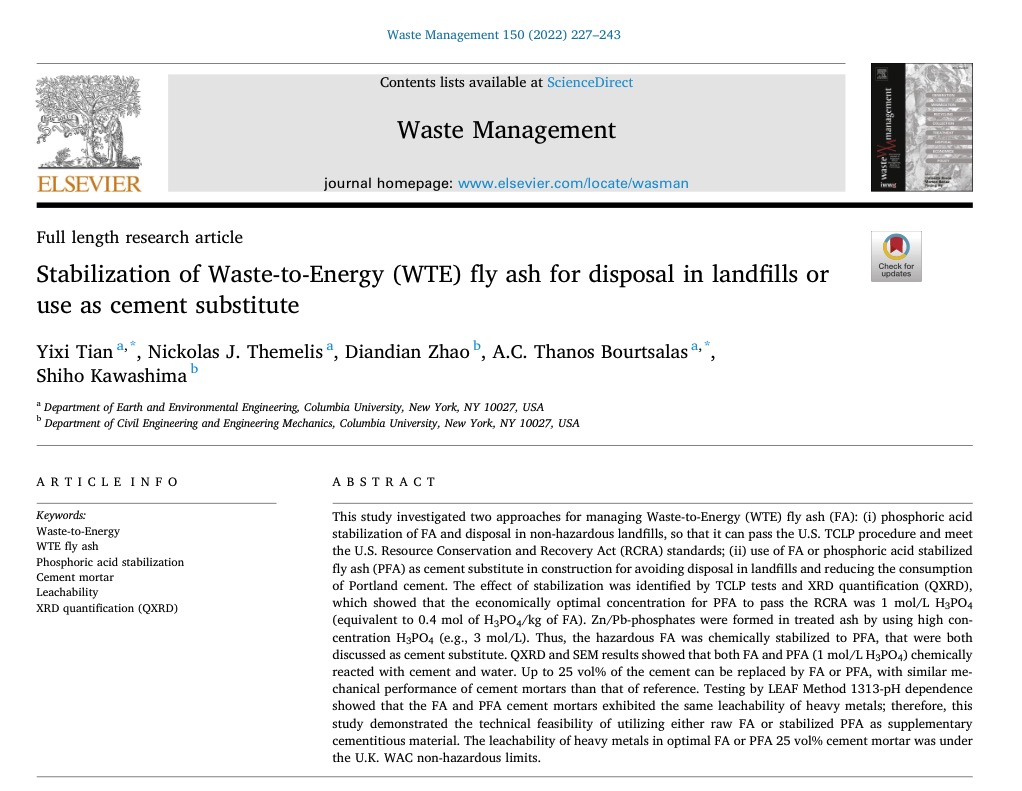Stabilization of Waste-to-Energy (WTE) fly ash for disposal in landfills or use as cement substitute
By Yixi Tian*, Nickolas J. Themelis, Diandian Zhao, A.C. (Thanos) Bourtsalas*, Shiho Kawashima
Journal: Waste Management Volume 150 (1 August 2022), 227-243
Department of Earth and Environmental Engineering
Fu Foundation School of Engineering & Applied Science
Columbia University
The study was supported by the Earth Engineering Center of Columbia University and Global WtERT Council, Inc. The authors gratefully acknowledge the contribution of the engineers of Covanta for the sample collection.
Highlights
- • Quantify the effects of H3PO4 treatment on mineralogy of WTE fly ash (FA).
-
• Optimal 1 M H3PO4 phosphated fly ash (PFA) can pass the US TCLP and RCRA standards.
• Study the FA and PFA reactions with Portland cement by XRD quantification.
• 0–25 vol% FA or PFA replacement improves the mechanical strength of cement mortar.
- • FA or PFA can be used as cement substitutes in mortars by LEAF leachability tests.
Abstract
This study investigated two approaches for managing Waste-to-Energy (WTE) fly ash (FA): (i) phosphoric acid stabilization of FA and disposal in non-hazardous landfills, so that it can pass the U.S. TCLP procedure and meet the U.S. Resource Conservation and Recovery Act (RCRA) standards; (ii) use of FA or phosphoric acid stabilized fly ash (PFA) as cement substitute in construction for avoiding disposal in landfills and reducing the consumption of Portland cement. The effect of stabilization was identified by TCLP tests and XRD quantification (QXRD), which showed that the economically optimal concentration for PFA to pass the RCRA was 1 mol/L H3PO (equivalent to 0.4 mol of H3PO4/kg of FA). Zn/Pb-phosphates were formed in treated ash by using high con- centration H3PO4 (e.g., 3 mol/L). Thus, the hazardous FA was chemically stabilized to PFA, that were both discussed as cement substitute. QXRD and SEM results showed that both FA and PFA (1 mol/L H3PO4) chemically reacted with cement and water. Up to 25 vol% of the cement can be replaced by FA or PFA, with similar me4- chanical performance of cement mortars than that of reference. Testing by LEAF Method 1313-pH dependence showed that the FA and PFA cement mortars exhibited the same leachability of heavy metals; therefore, this study demonstrated the technical feasibility of utilizing either raw FA or stabilized PFA as supplementary cementitious material. The leachability of heavy metals in optimal FA or PFA 25 vol% cement mortar was under the U.K. WAC non-hazardous limits.
Please click/cite the link to the journal: https://doi.org/10.1016/j.wasman.2022.06.043 .

